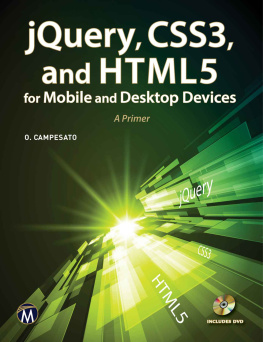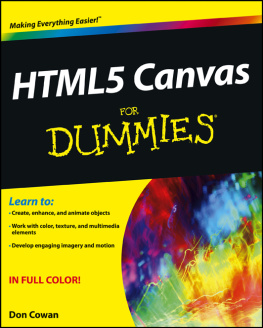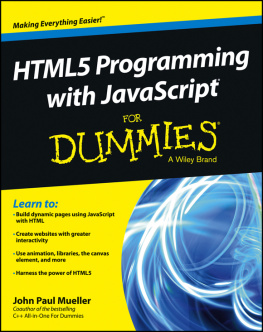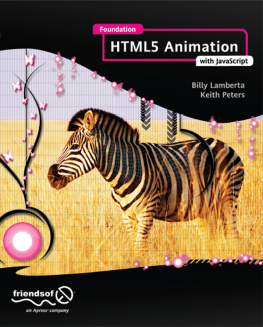Readers of this book should have a good working knowledge of creating websites and web applicationsand in particular, the use of JavaScript.
I like jQuery because it speeds up development, and many of the code samples include this library by default. In general, any external libraries and associated files are included from a reliable content delivery network such as Googles, thus avoiding the need for you to copy files to your own web space.
Math has been kept to a minimum, although some of the examples use basic vectors and trigonometry.
Organization
The book is fast paced, with the first graphics programming examples appearing in .
In the subsequent chapters, I cover a variety of graphics-oriented topics, focusing primarily on subjects that can add impressive visual impact and interactivity to your web applications.
No book about interactive graphics would be complete without a discussion of video games. Well explore this subject in depth by developing a full video game application, as well as examining features that are useful for games projects, such as sprites and scrolling.
The topics covered in each chapter can be summarized as follows:
Covers JavaScript object-oriented programming techniques as well as code optimizations (including jQuery optimizations) that are useful where performance is important in graphics-based applications. Well also discuss the little-used JavaScript binary operators and how you can use them for optimization.
Shows how regular DOM manipulation (DHTML) can be used for fast-moving graphics. Well develop a sprite system (useful for games and other effects) and see how it works within the context of a jQuery plug-in.
Covers basic CSS scrolling techniques, including parallax effects. Well then move on to JavaScript-controlled scrolling and finally to a fast, tile-based parallax scrolling system. Ill introduce you to the powerful Tiled map editor, showing you how to create tile-based maps.
Includes coverage of the user interface libraries jQuery UI and Ext JS. Well explore the differing approaches of the two libraries and their respective suitabilities for various types of applications. In addition to using existing UI libraries, well build a 3D carousel from scratch.
Demonstrates how to build fun and playable games without resorting to external plug-ins such as Flash. Subjects covered include collision detection and object handling. Well also develop a full retro-style arcade game to illustrate in action the techniques weve discussed.
Examines the Canvas element in depth, with numerous examplesincluding how to develop a graphical chat application using Canvas and WebSockets. Canvas topics include an introduction to basic drawing, strokes, fills, gradients, recursive drawing, bitmaps, and animation.
Covers the myriad uses for 2D vectors in graphical applications and games, proving that a little bit of math can go a long way. Code examples include cannon and rocket simulations with realistic movement.
Explores Google Chart Tools, an expansive resource of data visualization tools that can put an exciting spin on most kinds of data. From bar charts to Google-O-Meter gauges, this chapter covers the implementation of both static and interactive charts and other graphical visualizations in your applications. It includes the crucial topic of formatting your data in the correct way for Chart Tools to use.
Describes jQuery Mobile, a framework built on top of jQuery to provide a unified user interface to mobile-targeted web applications. jQuery Mobile turns regular HTML pages into an interactive and animated mobile experience. This chapter covers the development of a graphical sliding puzzle game specifically geared to the jQuery UI and mobile devices.
Want to create a native mobile application using your usual web development skills? PhoneGap comes to the rescue. This chapter explains how to install and configure PhoneGap to create native Android applications. After we walk through installation and configuration, well convert the sliding puzzle game we developed in into a native app ready for deployment to mobile devices.
Conventions Used in This Book
The following typographical conventions are used in this book:
Italic
Indicates new terms, URLs, email addresses, filenames, and file extensions.
Constant widthIndicates computer code in a broad sense, including commands, arrays, elements, statements, options, switches, variables, attributes, keys, functions, types, classes, namespaces, methods, modules, properties, parameters, values, objects, events, event handlers, XML tags, HTML tags, macros, the contents of files, and the output from commands.
Constant width boldShows commands or other text that should be typed literally by the user.
Constant width italicShows text that should be replaced with user-supplied values or by values determined by context.
Note
This icon signifies a tip, suggestion, or general note.
Warning
This icon indicates a warning or caution.
Websites and pages are mentioned in this book to help you locate online information that might be useful. Normally I specify both the address (URL) and the name (title, heading) of a page. Some addresses are relatively complicated, so you can probably locate the pages more easily by using your favorite search engine to find a page by its name, typically by entering it inside quotation marks. This method may also help if you cant find the page by its address; it may have simply moved elsewhere, so the name could still work.

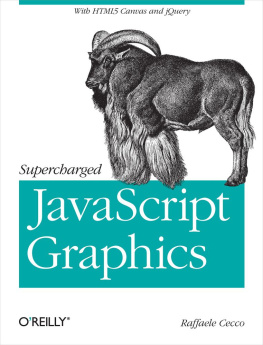
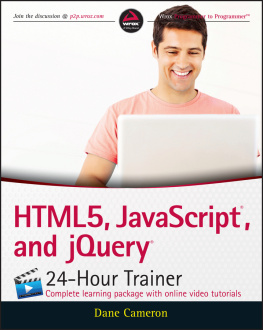

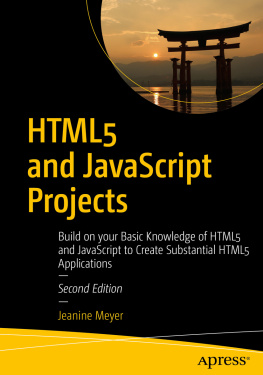
![Jeanine Meyer [Jeanine Meyer] - HTML5 and JavaScript Projects: Build on your Basic Knowledge of HTML5 and JavaScript to Create Substantial HTML5 Applications](/uploads/posts/book/120565/thumbs/jeanine-meyer-jeanine-meyer-html5-and.jpg)
